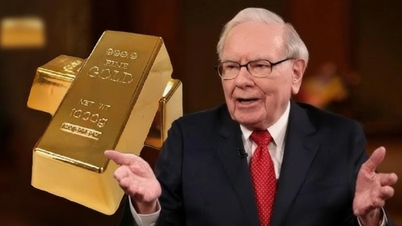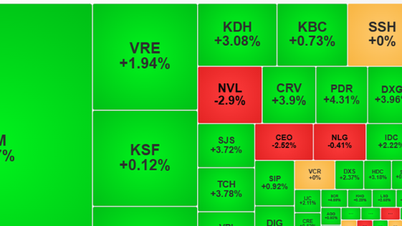Gold prices fell sharply across three continents.
Opening the first trading session of the week on October 27 on the New York market (October 27 evening Vietnam time), the spot gold price continued to decrease by more than 125 USD, equivalent to 3.1%, down below the threshold of 3,990 USD/ounce (about 127.3 million VND/tael, converted according to the bank exchange rate). Previously, on the European and Asian markets, the gold price had decreased sharply compared to the end of last week.
This decline continued a series of strong adjustments in the week of October 20-24, when the precious metal experienced a rare deep decline in a decade. From the historical peak of 4,381 USD/ounce (nearly 140 million VND/tael) set on October 21, the gold price fell to 4,100 USD/ounce at the end of the week, a loss of more than 390 USD/ounce (12.4 million VND/tael).
In the domestic market, the decline was slower. At the end of October 27, the price of SJC gold bars decreased slightly by VND100,000/tael compared to the end of last week, down to VND148.4 million/tael (sold). Gold rings only decreased by a few hundred thousand VND, remaining at around VND149-150 million/tael. Some local gold brands decreased more sharply, losing VND1-2 million/tael during the day and about ten million VND compared to the peak.
SJC gold bars alone have decreased by about 5 million VND/tael in the past week, but transactions in the market are still quite quiet.

Gold prices fell sharply. Photo: HH
The main reason for the world gold price plunge is the massive profit-taking wave after a long period of price increase. Since the beginning of the year, gold has increased by more than 60%, following the 27% increase in 2024, causing many investors to choose to "exit" when the price is considered too high.
At the same time, the recovery of the US dollar and the rise in US bond yields have reduced the attractiveness of gold, which is a non-interest-bearing asset. Risk sentiment has also increased after positive signals from US-China trade negotiations, causing money to shift to stocks and industrial goods.
In the session on October 27, global stocks increased simultaneously: Japan's Nikkei 225 surpassed 50,000 points for the first time, Korea's Kospi surpassed 4,000 points, and the Dow Jones, S&P 500 and Nasdaq indexes all set new records.
Selling pressure is still high
Earlier, on Kitco, analysts said that the strong rally in global stocks and the excitement about trade have caused a sharp decrease in demand for shelter, causing gold to plummet. Gold is expected to have another drop before stabilizing.
According to Kitco, many Wall Street experts have turned neutral or negative on gold in the short term. In the weekly survey, only 18% of experts forecast prices will increase, while 35% said they will decrease, and the remaining 47% predicted a sideways trend.
Several factors are putting downward pressure on gold prices. The US-China trade deal is progressing positively, with the US suspending 100% tariffs and China suspending restrictions on rare earth exports. Global stocks are rallying, money is flowing out of safe-haven assets. US bond yields are rising, increasing the opportunity cost of holding gold. The greenback is temporarily maintaining relative strength compared to other currencies.
Many investors are concerned that if the psychological support level of 4,000 USD/ounce is broken, gold will fall further.
However, on the other hand, some experts believe that the decline of gold may soon slow down. Mr. Ryan McIntyre, managing partner at Sprott Inc, commented that economic and geopolitical risks remain high. In that context, gold still plays an important role as a safe haven asset.
Similarly, according to expert Ole Hansen from Saxo Bank, the sharp fall to around $4,000/ounce is “a necessary correction” to help eliminate excessive excitement and open a new accumulation cycle. Hansen assessed that after the correction, gold is no longer in a state of “overbought” while the demand for ownership is still very large.
Although gold is under short-term selling pressure, many major financial institutions still maintain a positive view in the medium and long term. Supporting factors include: the USD tends to weaken as the Fed enters a rate-cutting cycle; demand for safe havens increases again amid geopolitical instability; the US-China strategic competition has not cooled down and central banks still maintain record high gold purchases.
According to Citigroup's forecast, gold prices could fluctuate around $4,300-$4,500/ounce in the first half of 2026 if the US dollar weakens and the Fed cuts interest rates twice more. Meanwhile, Goldman Sachs expects gold to surpass $4,700/ounce in 2027.
So, the gold bull run may not be over yet. However, a deep correction is ahead. If the $4,000/ounce mark is breached, gold could fall to $3,900 or even $3,850/ounce.

Gold prices rebound after US inflation data, not yet out of the red Gold prices rebounded strongly after the US announced weaker-than-expected inflation but still not enough to offset the sell-off this week. Gold ended a streak of 9 consecutive weeks of gains, a signal that the precious metal needs to fall a bit more before stabilizing.
Source: https://vietnamnet.vn/sau-con-sot-gia-vang-boc-hoi-12-trieu-dong-luong-co-con-giam-nua-2456908.html




![[Photo] President Luong Cuong attends the 80th Anniversary of the Traditional Day of the Armed Forces of Military Region 3](https://vphoto.vietnam.vn/thumb/1200x675/vietnam/resource/IMAGE/2025/10/28/1761635584312_ndo_br_1-jpg.webp)






























![[Photo] Party Committees of Central Party agencies summarize the implementation of Resolution No. 18-NQ/TW and the direction of the Party Congress](https://vphoto.vietnam.vn/thumb/1200x675/vietnam/resource/IMAGE/2025/10/27/1761545645968_ndo_br_1-jpg.webp)
![[Photo] The 5th Patriotic Emulation Congress of the Central Inspection Commission](https://vphoto.vietnam.vn/thumb/1200x675/vietnam/resource/IMAGE/2025/10/27/1761566862838_ndo_br_1-1858-jpg.webp)
![[Photo] National Assembly Chairman Tran Thanh Man receives Chairman of the House of Representatives of Uzbekistan Nuriddin Ismoilov](https://vphoto.vietnam.vn/thumb/1200x675/vietnam/resource/IMAGE/2025/10/27/1761542647910_bnd-2610-jpg.webp)







































































Comment (0)